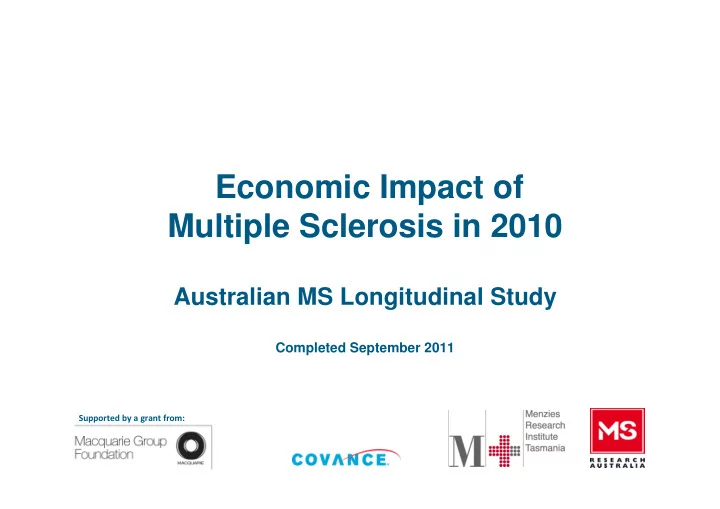

Economic Impact of Multiple Sclerosis in 2010 Australian MS Longitudinal Study Completed September 2011 Supported by a grant from:
Overview � Multiple sclerosis � Prevalence � Healthcare costs and indirect costs � Quality of life � Conclusions � Recommendations
Multiple sclerosis • Progressive, chronic disease of the central nervous system (brain and spinal cord). • Most frequent neurological disease in young and middle- aged adults • Involves multiple areas of the central nervous system • Variable and complex range of symptoms – visual disturbance – fatigue – pain – reduced mobility and coordination – cognitive impairment – mood changes
Multiple sclerosis • Most common form of MS is relapsing-remitting • Majority eventually enter a progressive phase with accumulating disability • 10% of people with MS have a primary progressive disease at onset • Average age at onset is between 20 and 40 • 75% of people with MS are women • Treatments can reduce relapse, but there is no cure MS tends to strike people in their most productive years, impacting on careers, relationships, family, and social life
Prevalence of Multiple Sclerosis � Approximately 21,200 people with MS in Australia in 2010 � Prevalence increased by 4% per year since 2005 � Australia-wide 95.2 per 100,000 persons � There is a latitude gradient of MS prevalence in Australia with prevalence in Tasmania double that in Queensland � Around 1,200 (5.7%) living in establishments
Annual cost of Multiple Sclerosis Cost of MS by cost categories in 2010 2010 Cost per person with MS Total $M Cost category Direct costs – personal $3,697 $78 Direct costs – community / government $10,721 $227 Nursing home and equivalent costs $4,384 $93 Informal Care $6,857 $145 Indirect costs $23,286 $494 Total costs $48,945 $1,038
Cost of MS by severity – per person Notes: Mild severity includes EDSS levels 1 - 3, Moderate includes 4 – 6, Severe includes levels 6.5 – 9. Nursing home costs are excluded as they are unable to be broken down by MS severity.
Annual cost of MS by severity Mild Moderate Severe Cost of MS $36,369 $58,890 $65,305 per person Total cost of MS $341,117 $413,819 $219,724 ($000’s) Total cost for people with MS where severity not stated, $62,967,000. Overall Total Cost, therefore $1.04 billion
Costs of MS by age – per person
Annual cost of MS by age group Not stated <35 35-44 45-54 55-64 65+ Total Cost of MS $38,478 $40,958 $46,874 $69,379 $21,804 $50,898 $48,945 per person Total cost $49,625 $151,223 $300,074 $460,668 $64,274 $12,124 $1,037,627 of MS ($000’s)
Cost of MS by gender – per person
Cost of MS by gender - total
Direct annual costs Direct costs - by cost category and disease severity - per person with MS
Cost of MS in 2005 and 2010 Cost of MS by cost categories in 2005 and 2010 ($M)
Utility and Quality of Life Utility and Quality of Life measured by WHO QoL � The utility for Australians aged 50-59 (average age of people with MS) is 0.8 � Mean utility for people with MS is 0.65 (a 20% reduction) � There is a 50% reduction in utility as MS becomes severe
Conclusions � An estimated 21,200 Australians live with MS � Prevalence of MS is increasing by 4% per year � There are substantial health costs and indirect costs associated with MS – a total of $1.04 billion per year � Costs increase with severity through: � Increased need for community and private care � Alteration to cars and houses � Costs increase despite people with severe MS no longer being eligible for PBS-reimbursed medicines
Conclusions � Indirect costs increase with MS severity through: � Loss of employment with increased disability � The impact of this on families is compounded by increasing personal costs as severity increases � Reduction in quality of life associated with MS is equivalent to stroke and end stage cancer: � 20% reduction in utility in MS patients � increases to 50% when MS becomes severe
Policy Recommendations Problem: • MS imposes a substantial economic and social burden on the people with the condition and the community as a whole • The burden increases with severity Solution: Investment in research and innovations to delay or ideally prevent the progression of the condition could bring substantial rewards
Policy Recommendations Problem: The greatest proportion of the cost of MS to the individual and society lies in lost productivity Solution: • Investment in resources, services and environments that assist people with MS to retain employment is of paramount importance • Development of a National Disability Insurance Scheme is fully supported
Thank you Supported by a grant from Macquarie Group Foundation and unrestricted grants from MSRA’s industry round-table
Recommend
More recommend